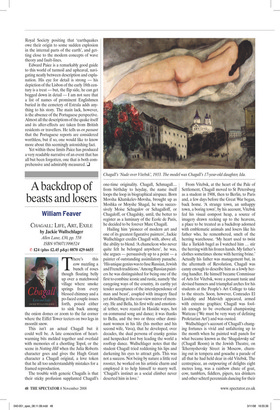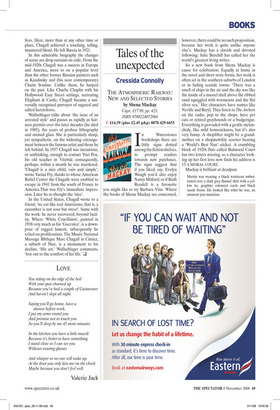A backdrop of beasts and losers
William Feaver
CHAGALL: LiFE, ART, ExiLE by Jackie Wullschlager Allen Lane, £30, pp. 558 ISBN 9780713996524 ✆ £24 (plus £2.45 p&p) 0870 429 6655 There’s this cow nuzzling a bunch of roses though floating belly up over a matchwood village where smoke springs from every blessed chimney and a po-faced couple issues forth, poised either to sink back among the onion domes or zoom to the far corner where the Eiffel Tower teeters on two legs in moonlit snow.
This isn’t an actual Chagall but it could well be. A late concoction of heartwarming bits melded together and overlaid with memories of a chortling Topol, or the scene in Notting Hill when the Julia Roberts character goes and gives the Hugh Grant character a Chagall original, a love token that he all too understandably mistakes for a framed reproduction.
The trouble with generic Chagalls is that their sticky profusion supplanted Chagall’s one-time originality. Chagall, Schmagall... from birthday to heyday, the name itself loops the loop in biographical airspace. Born Movsha Khatskelev-Movsha, brought up as Moshka or Moyshe Shagal, he was successively Moise Schagalov or Schagalloff, or Chagaloff, or Chagalsky, until, the better to register as a luminary of the Ecole de Paris, he decided to be forever Marc Chagall.
Hailing him ‘pioneer of modern art and one of its greatest figurative painters’, Jackie Wullschlager credits Chagall with, above all, the ability to blend. ‘A chameleon who never quite felt he belonged anywhere’, he was, she argues — persuasively up to a point — a painter of outstanding assimilatory panache. ‘His unique genius was to fuse Russian, Jewish and French traditions.’ Among Russian painters he was distinguished for being one of the first to combine iconic and rustic, namely ‘the easygoing ways of the country, its earthy yet tender acceptance of the interdependence of man and beast’, coupled with imagery fixed yet dwindling in the rear-view mirror of memory. He and Bella, his first wife and emotional tether, were reared in Hasidic ways, hot on communal song and dance; it was thanks to Bella, and the two or three other dominant women in his life (his mother and his second wife, Vava), that he developed, over decades, the dual persona of cranky genius and henpecked lost boy leading the world a rooftop dance. Wullschlager notes that the student Chagall tried reddening his lips and darkening his eyes to attract girls. This was not a success. Not being by nature a little red rooster, he worked on his artistic charm and employed it to help himself to marry well. ‘Chagall’s instinct as a social climber never deserted him in love.’ From Vitebsk, at the heart of the Pale of Settlement, Chagall moved to St Petersburg as a student in 1908, then to Berlin, to Paris and, a few days before the Great War began, back home. ‘A strange town, an unhappy town, a boring town’, by his account, Vitebsk fed his visual compost heap, a source of imagery drawn reeking up to the heavens, a place to be treated as a backdrop adorned with emblematic animals and losers like his father who, he remembered, smelt of the herring warehouse. ‘My heart used to twist like a Turkish bagel as I watched him ... stir the herring with his frozen hands. My father’s clothes sometimes shone with herring brine.’ Actually his father was management but, in the aftermath of Revolution, Chagall was canny enough to describe him as a lowly herring handler. He himself became Commissar of Arts for Vitebsk, wore a peasant tunic and devised banners and triumphal arches for his students at the People’s Art College to take to the streets. Soon, however, Comrades El Lissitzky and Malevich appeared, armed with extreme graphics; Chagall was foolish enough to be overheard championing Watteau (‘We must be very wary of defining Proletarian Art’) and was ousted.
Wullschlager’s account of Chagall’s changing fortunes is vivid and unfaltering up to the month when he painted wall panels for what became known as the ‘Shagalovsky sal’ (Chagall Room) in the Jewish Theatre, on Tchernyshevsky Street in Moscow, churning out in tempera and gouache a parade of all that he had held dear in old Vitebsk. The centrepiece, an outpouring of delights eight metres long, was a rainbow chute of goat, cow, tumblers, fiddlers, pipers, tea drinkers and other schtetl perennials dancing for their lives. Here, more than at any other time or place, Chagall achieved a touching, telling, mannered blend. He left Russia in 1921.
In this admirable biography the changes of scene are drop curtains on exile. From the mid-1920s Chagall was a success in Europe and America, more so on a popular level than the other former Russian painters such as Kandinsky and (his near contemporary) Chaim Soutine. Unlike them, he harped on the past. Like Charlie Chaplin with his Hollywood Easy Street settings, recreating Elephant & Castle, Chagall became a universally recognised purveyor of sugared and salted heretofores.
Wullschlager talks about ‘the issue of an arrested style’ and passes as rapidly as fairness permits over the later decades (he died in 1985), the years of profuse lithography and stained glass. She is particularly sharp, yet sympathetic, on the widening estrangement between the famous artist and those he left behind. In 1937 Chagall was incautious, or unthinking, enough to contact Yuri Pen, his old teacher in Vitebsk; consequently, perhaps, within a month he was murdered. ‘Chagall is a nice child, vain and simple’, wrote Varian Fry, thanks to whose American Relief Center the Chagalls were enabled to escape in 1941 from the south of France to America.That was Fry’s immediate impression. Later he re-thought the ‘nice’.
In the United States, Chagall wrote to a friend, ‘we eat like real Americans, that is, a cucumber is not sour but sweet’. Same with the work: he never recovered, beyond facility. Where ‘White Crucifixion’, painted in 1938 very much as his ‘Guernica’, is a downpour of ragged lament, subsequently he relied on proliferation. The Musée National Message Biblique Marc Chagall in Cimiez, a suburb of Nice, is a monument to his decline. ‘His art,’ Wullschlager comments, ‘lost out to the comfort of his life.’ q



















































































 Previous page
Previous page